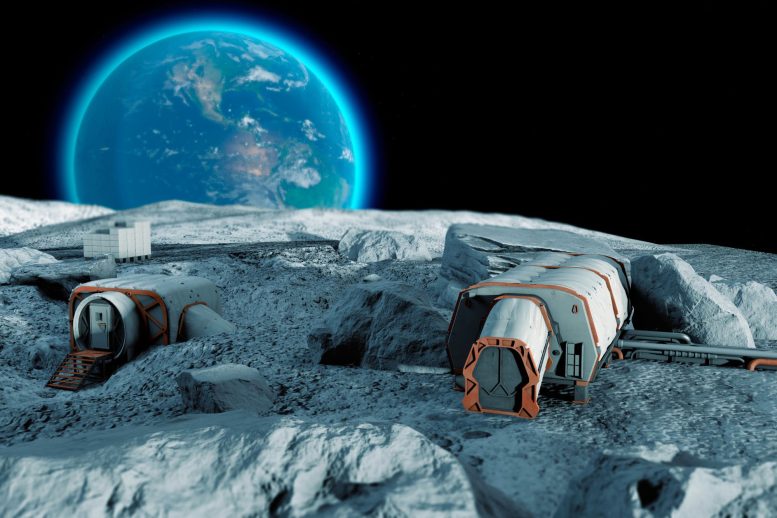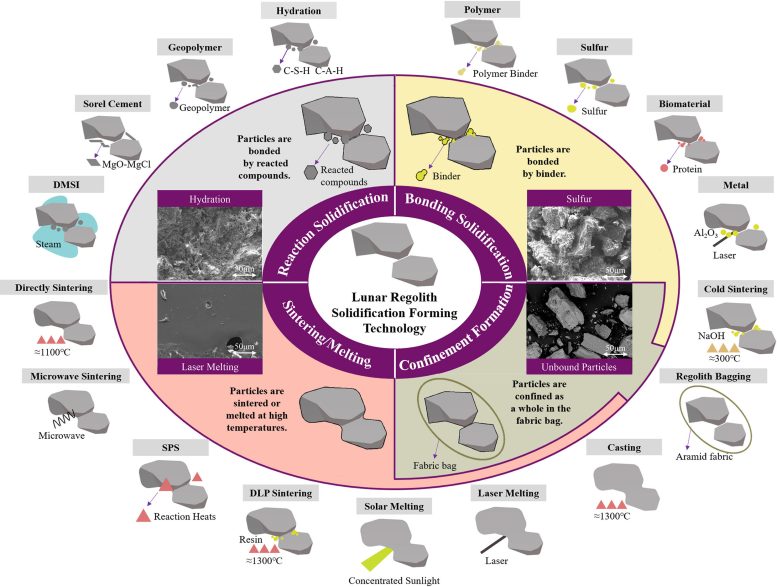
How Lunar Regolith Is Transforming Habitat Design
-
by Anoop Singh
- 5

New research reviews various techniques for lunar regolith construction, highlighting the categorization and evaluation of these methods to optimize lunar construction efficiency. It details a strategic plan for developing lunar infrastructure across four stages, from laboratories to self-sustaining habitats.
Scientists conducted a quantitative evaluation of techniques for solidifying and forming lunar regolith.
As lunar missions transition from exploration to building and using structures, constructing on the moon using local materials becomes essential. The focus is on solidifying and shaping lunar soil to make the most of local resources and reduce the costs of transportation and maintenance. To date, almost 20 different methods have been developed for making building materials from lunar regolith, each with unique needs and features.
Professor Feng from Tsinghua University has conducted a comprehensive review, precise classification, and quantitative evaluation of regolith solidification and formation techniques, shedding light on key challenges and future development directions.
Based on the technical mechanisms of bonding and cohesion between particles, regolith solidification and formation technologies can be categorized into four groups: reaction solidification (RS), sintering/melting (SM), bonding solidification (BS), and confinement formation (CF) methods. Specific techniques are further categorized based on implementation requirements, establishing a robust technological composition system. This research quantitatively describes each technique, summarizing processes and performance parameters.
In reaction solidification, regolith particles are bonded together through reacted compounds. This method relies on reaction materials transported by rockets, with local regolith typically comprising 60-95% of the overall mixture. Sintering/melting involves subjecting the regolith to high-temperature treatment, with in situ ratios commonly reaching 100%. However, heating temperatures exceeding 1000℃ can pose challenges regarding energy supply and equipment operation. Alternatively, bonding solidification utilizes binders to adhere particles, with an in situ ratio of 65-95%.

Based on the technical mechanisms of bonding and cohesion between particles, regolith solidification and formation technologies can be categorized into four groups: reaction solidification (RS), sintering/melting (SM), bonding solidification (BS), and confinement formation (CF) methods. Credit: Charun Bao
This method requires lower temperatures and less time for solidification. Confinement formation employs fabric to constrain regolith, forming regolith bag components through overall confinement without establishing connections between particles. With an in situ ratio of up to 99%, this method demands relatively low temperature and time requirements, while the formed components exhibit tensile advantage but may lack sufficient compressive strength.
Evaluation and Application of Techniques
In the quest for cost-effective and high-performance materials for lunar construction, researchers face the challenge of minimizing resource consumption, energy requirements, and operational complexity while ensuring reliability in the lunar environment. To address this, the research team introduces the 8IMEM quantification method, encompassing eight evaluation indicators and scoring thresholds tailored to construction needs.
According to the evaluation results, regolith bagging emerges as the highest-rated technique, demanding lower material, equipment, and energy requirements and enabling rapid formation of large components. It offers promising prospects for large-scale in situ lunar construction. Sintering/melting techniques consistently rank high, while casting techniques exhibit exceptional curing strength, rendering them suitable for manufacturing critical components. Solar melting techniques directly harness solar energy, making them ideal for low-energy consumption construction.
To align with lunar construction conditions and the long-term goals of the International Lunar Research Stations, a comprehensive four-stage plan has been devised: Laboratory, Research Station, Residence, and Habitat. Each stage has specific functions and distinct construction objectives, ensuring a progressive and sustainable development of lunar infrastructure. The Laboratory stage primarily supports unmanned research projects, while the Research Station stage accommodates astronauts for temporary scientific research missions. The Residence stage is designed to meet all the work and life requirements of astronauts on the Moon, resembling a space station in functionality.
Lastly, the Habitat stage is envisioned as a self-sustaining habitat for human life and a relay station for deep space exploration. To achieve the construction objectives of each stage, the research team further analyzed the structural construction objectives. Based on quantitative evaluations, they proposed regolith bag technology as a solution for lunar base construction.
By leveraging the insights derived from this comprehensive evaluation, researchers can make informed decisions on material preparation techniques, paving the way for optimized lunar construction endeavors. Additionally, the proposed lunar habitat design based on regolith bags is a practical reference for future research.
Reference: “Lunar In Situ Large-Scale Construction: Quantitative Evaluation of Regolith Solidification Techniques” by Charun Bao, Daobo Zhang, Qinyu Wang, Yifei Cui and Peng Feng, 24 March 2024, Engineering.
DOI: 10.1016/j.eng.2024.03.004
New research reviews various techniques for lunar regolith construction, highlighting the categorization and evaluation of these methods to optimize lunar construction efficiency. It details a strategic plan for developing lunar infrastructure across four stages, from laboratories to self-sustaining habitats. Scientists conducted a quantitative evaluation of techniques for solidifying and forming lunar regolith. As lunar missions…
New research reviews various techniques for lunar regolith construction, highlighting the categorization and evaluation of these methods to optimize lunar construction efficiency. It details a strategic plan for developing lunar infrastructure across four stages, from laboratories to self-sustaining habitats. Scientists conducted a quantitative evaluation of techniques for solidifying and forming lunar regolith. As lunar missions…
